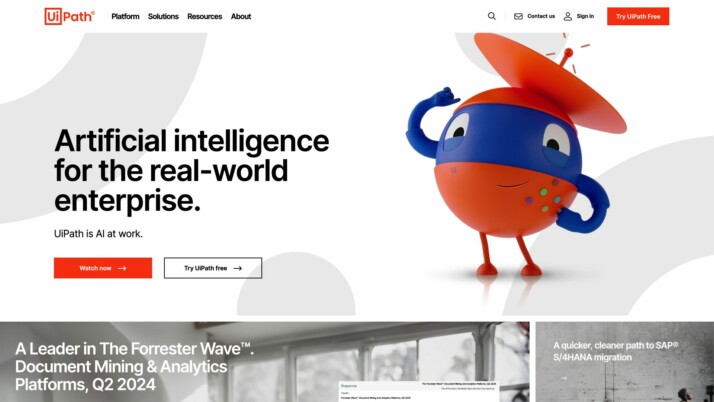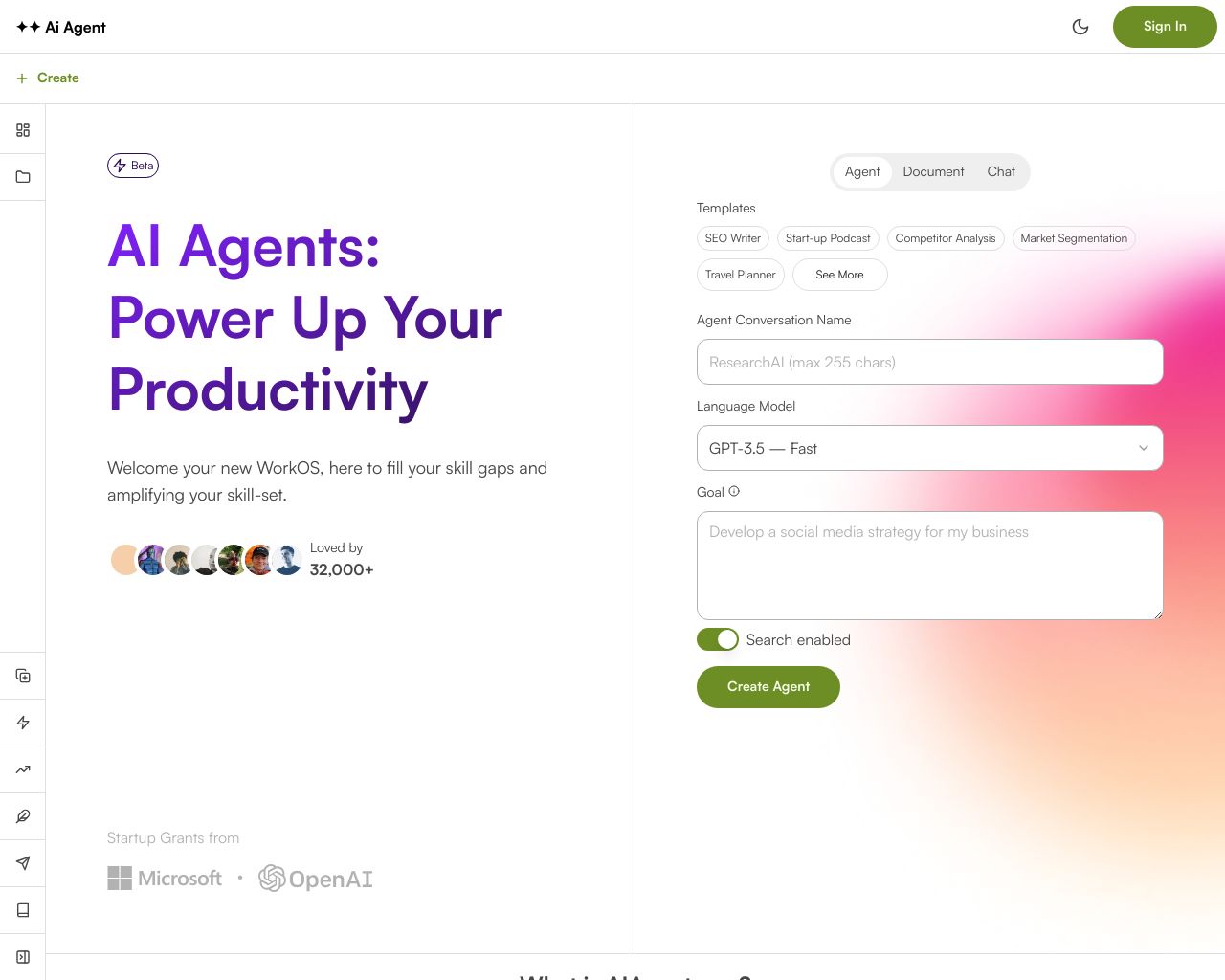The AI landscape brims with innovative solutions, each vying to streamline workflows and boost productivity. This review delves into three contenders: UiPath vs. AI Agent, and SmythOS. UiPath’s robust RPA platform excels in enterprise-grade automation, while AI Agent offers user-friendly AI assistant creation. SmythOS, however, emerges as the standout choice, blending advanced AI capabilities with unparalleled accessibility. We’ll explore how each platform tackles automation challenges, examining their strengths, limitations, and ideal use cases. Whether you’re a developer seeking powerful APIs, a business leader focused on scalability, or a non-technical professional looking for no-code solutions, this comparison will guide you through the features that matter most. Prepare to discover which platform best aligns with your automation goals and technical expertise.
UiPath Overview
UiPath revolutionizes business automation with its comprehensive robotic process automation (RPA) platform. The company’s flagship product, the UiPath Enterprise RPA Platform, empowers organizations to automate repetitive tasks, streamline workflows, and boost productivity across departments.


UiPath’s platform caters to a wide range of users, from citizen developers to IT professionals. Its visual development environment, UiPath Studio, allows users to design automation workflows through an intuitive drag-and-drop interface. For those without coding experience, UiPath StudioX offers a simplified version tailored for business users. These tools enable the rapid creation of software robots capable of mimicking human actions, from data entry to complex decision-making processes.
UiPath’s platform caters to a wide range of users, from citizen developers to IT professionals. Its visual development environment, UiPath Studio, allows users to design automation workflows through an intuitive drag-and-drop interface.
UiPath excels in enterprise-grade features, including robust security measures, scalability, and centralized management through UiPath Orchestrator. This cloud-based control center facilitates the deployment, scheduling, and monitoring of automation robots across an organization. UiPath’s AI Center further enhances its capabilities, allowing seamless integration of machine learning models into automation workflows.
While UiPath offers powerful automation tools, users may face a learning curve when tackling complex processes. The platform’s extensive feature set can be overwhelming for newcomers, potentially requiring dedicated training or specialized expertise for optimal utilization. Additionally, while UiPath provides strong RPA capabilities, it may not offer the same level of advanced AI agent functionalities found in some specialized AI platforms.
UiPath’s commitment to interoperability shines through its extensive integration capabilities. The platform connects seamlessly with a vast array of enterprise systems, cloud services, and productivity tools. This flexibility allows organizations to leverage UiPath alongside existing technology investments, creating cohesive automation ecosystems that span multiple departments and processes.
AI Agent Overview
AI Agent empowers users to create and deploy AI-powered assistants without extensive technical expertise. The platform’s visual workflow builder and pre-defined templates streamline the process of automating tasks across various domains, from email drafting to data integration.


AI Agent’s strength lies in its extensive integration capabilities, connecting AI assistants to over 6,000 applications. This versatility allows users to automate workflows across popular tools like Google Sheets and Notion. The platform caters to a wide range of use cases, including SEO writing, social media management, competitor analysis, and travel planning.
AI Agent’s strength lies in its extensive integration capabilities, connecting AI assistants to over 6,000 applications. This versatility allows users to automate workflows across popular tools…
The user-friendly interface eliminates the need for coding skills, making AI technology accessible to professionals across various industries. AI Agent offers customizable behaviors and instant actions, giving users precise control over how their AI assistants interact and perform tasks. The platform supports multiple data sources and enables real-time task execution during user interactions.
AI Agent provides tiered subscription plans, including free and premium options. Higher-tier plans offer access to advanced features like GPT-4 integration, the ability to run multiple agents simultaneously, and enhanced support. While the platform excels in ease of use and integration options, it may have limitations in terms of advanced customization for highly specialized use cases compared to more developer-focused alternatives.
Feature Comparison
UiPath and AI Agent offer distinct approaches to automation and AI implementation, with notable differences in their core capabilities and target use cases.
UiPath excels in robotic process automation (RPA), providing robust tools for automating structured business processes. Its visual development environment, UiPath Studio, enables users to create complex automation workflows through drag-and-drop interfaces. UiPath’s strength lies in enterprise-grade features like centralized management through UiPath Orchestrator and extensive integration with existing business systems.
AI Agent, on the other hand, focuses on creating AI-powered assistants without extensive technical expertise. Its platform emphasizes ease of use, offering pre-defined templates and a visual workflow builder that connects to over 6,000 applications. AI Agent caters to a broader range of users, including non-technical professionals, enabling them to automate tasks across various domains.
A key distinction emerges in the area of AI capabilities. While UiPath offers AI integration through its AI Center, allowing the incorporation of machine learning models into automation workflows, AI Agent’s core functionality revolves around creating and deploying AI assistants. AI Agent provides more accessible tools for building conversational AI and problem-solving agents, whereas UiPath’s AI features are more geared towards enhancing RPA processes.
In terms of security and enterprise readiness, UiPath maintains an edge with its comprehensive governance and security features, including robust encryption and access control mechanisms. AI Agent, while offering secure integrations, may not match UiPath’s enterprise-grade security infrastructure.
UiPath’s scalability and enterprise focus contrast with AI Agent’s emphasis on user-friendly AI creation. While UiPath provides extensive support for large-scale deployments and complex business processes, AI Agent offers a more streamlined approach to building and deploying AI assistants for various business needs.
Feature Comparison Table
| UiPath | AI Agent | SmythOS | |
|---|---|---|---|
| CORE FEATURES | |||
| AI Agents | ❌ | ✅ | ✅ |
| Hosted Agents (Dev, Production) | ❌ | ✅ | ✅ |
| No-Code Options | ❌ | ✅ | ✅ |
| Memory & Context | ❌ | ✅ | ✅ |
| Autonomous Agents | ❌ | ✅ | ✅ |
| Explainability & Transparency | ❌ | ✅ | ✅ |
| Multimodal | ❌ | ✅ | ✅ |
| Problem-Solving Capabilities | ❌ | ✅ | ✅ |
| Multi-Agent Collaboration | ❌ | ✅ | ✅ |
| Audit Logs for Analytics | ✅ | ❌ | ✅ |
| Work as Team | ❌ | ✅ | ✅ |
| Agent Work Scheduler | ✅ | ❌ | ✅ |
| SECURITY | |||
| Constrained Alignment | ❌ | ❌ | ✅ |
| IP Control | ✅ | ❌ | ✅ |
| COMPONENTS | |||
| Foundation AIs | ❌ | ❌ | ✅ |
| Huggingface AIs | ❌ | ✅ | ✅ |
| Zapier APIs | ❌ | ✅ | ✅ |
| Classifiers | ❌ | ✅ | ✅ |
| Data Lakes | ❌ | ❌ | ✅ |
| DEPLOYMENT OPTIONS (EMBODIMENTS) | |||
| Deploy as API | ❌ | ✅ | ✅ |
| Deploy as Webhook | ❌ | ✅ | ✅ |
| Staging Domains | ❌ | ❌ | ✅ |
| Production Domains | ❌ | ❌ | ✅ |
| Deploy as Site Chat | ❌ | ✅ | ✅ |
| Deploy as Scheduled Agent | ❌ | ❌ | ✅ |
| Deploy as GPT | ❌ | ✅ | ✅ |
| DATA LAKE SUPPORT | |||
| Hosted Vector Database | ❌ | ❌ | ✅ |
| Sitemap Crawler | ❌ | ❌ | ✅ |
| YouTube Transcript Crawler | ❌ | ❌ | ✅ |
| URL Crawler | ❌ | ✅ | ✅ |
| TXT File Support | ❌ | ✅ | ✅ |
Best Alternative to UiPath and AI Agent
SmythOS stands out as the superior alternative to UiPath and AI Agent, offering a comprehensive AI automation platform that combines power, flexibility, and ease of use. Our drag-and-drop interface empowers users to create sophisticated AI agents without extensive coding knowledge, democratizing access to advanced AI capabilities.
Unlike UiPath’s focus on robotic process automation, SmythOS provides a versatile ecosystem for building intelligent agents that can handle a wide array of tasks, from data analysis to natural language processing. We offer seamless integration with popular AI models and APIs, allowing users to leverage cutting-edge technologies in their workflows. Our platform supports multimodal interactions, enabling agents to process and respond to various input types, including text, images, and voice.
SmythOS stands out as the superior alternative to UiPath and AI Agent, offering a comprehensive AI automation platform that combines power, flexibility, and ease of use.
While AI Agent emphasizes simplicity, SmythOS delivers a perfect balance of user-friendliness and advanced functionality. We provide robust tools for creating autonomous agents capable of complex problem-solving and decision-making. Our multi-agent collaboration feature sets us apart, allowing teams of AI agents to work together on intricate tasks, mirroring human team dynamics.
SmythOS excels in deployment flexibility, offering options to deploy agents as APIs, webhooks, scheduled tasks, or chatbots. This versatility, combined with our scalable infrastructure, ensures that SmythOS can adapt to diverse business needs and grow with your organization. We prioritize security and compliance, implementing features like constrained alignment and data encryption to protect your sensitive information and maintain ethical AI practices.
By choosing SmythOS, you gain access to a powerful, all-encompassing AI automation platform that surpasses the limitations of both UiPath and AI Agent. Our solution empowers you to build, deploy, and manage intelligent agents that drive innovation and efficiency across your organization, making SmythOS the clear choice for those seeking to harness the full potential of AI technology.
Conclusion
UiPath, AI Agent, and SmythOS each bring unique strengths to the table in the realm of automation and AI implementation. UiPath excels in robotic process automation with its comprehensive enterprise-grade platform, while AI Agent focuses on user-friendly AI assistant creation. However, SmythOS emerges as the superior choice, offering a powerful blend of advanced features and accessibility.
SmythOS stands out with its intuitive drag-and-drop interface, extensive integration ecosystem, and versatile deployment options. Unlike UiPath’s steep learning curve or AI Agent’s limitations in advanced customization, SmythOS democratizes AI development without sacrificing sophistication. Our platform supports multi-agent collaboration, provides pre-built API integrations, and offers unparalleled flexibility in connecting to various data sources and AI models.
While UiPath and AI Agent may suit specific use cases, SmythOS’s ’Create Once, Deploy Anywhere’ approach truly sets it apart. Our platform empowers users to build complex AI workflows and deploy them across multiple environments, from chatbots to APIs, with ease. This versatility, combined with our robust security features and scalability, makes SmythOS the ideal choice for businesses of all sizes looking to harness the full potential of AI.
Ready to experience the future of AI automation? Explore our diverse range of AI-powered agent templates to jumpstart your journey. Whether you’re a developer, business leader, or AI enthusiast, SmythOS has the tools you need to revolutionize your workflows. Create a free SmythOS account today and join the AI revolution – no commitment required, with a 30-day money-back guarantee. Transform your business with SmythOS and unlock the true power of AI-driven automation.